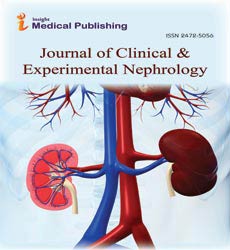Common Elements in Rare Kidney Diseases
Ahmed Zakir*
Department of Dermatology and Venereology, Bangabandhu Sheikh Mujib Medical University, India
- *Corresponding Author:
- Ahmed Zakir
Department of Dermatology and Venereology,
Bangabandhu Sheikh Mujib Medical University, India;
E-mail: zakirahmed@gmail.com
Received: February 18, 2022, Manuscript No. IPJCEN-22-11497; Editor assigned: February 21, 2022, PreQC No. IPJCEN-22-11497 (PQ); Reviewed: March 07, 2022, QC No. IPJCEN-22-11497; Revised: March 11, 2022, Manuscript No. IPJCEN-22-11497 (R); Published: March 18, 2022, Invoice No. IPJCEN-22-11497
Citation: Zakir A (2022) Common Elements in Rare Kidney Diseases. J Clin Exp Nephrol Vol:7 No:1
Editorial
Uncommon kidney illnesses envelop somewhere around 150 distinct conditions, the majority of which are acquired. Altough individual uncommon kidney infections raise explicit issues, as a gathering these uncommon illnesses can have covering difficulties in analysis and treatment. These difficulties incorporate little quantities of impacted patients, unidentified reasons for illness, absence of biomarkers for checking sickness movement, and need for complex consideration. The greater part is acquired while others, for example, the essential glomerulonephritides, have complex etiologies. For acquired kidney problems, analysis, the board, and treatment are intricate, particularly when they are related with multisystem entanglements. Patients frequently go through years visiting numerous medical care suppliers prior to getting a precise finding. Restorative advances in uncommon kidney sicknesses have been thwarted by a few variables, including unsettled hereditary imperfections, absence of biomarkers to screen illness movement, heterogeneous clinical aggregates, and obsolete indicative characterizations that don't reflect fundamental pathophysiological instruments. Together, innovative advances and coordinated support have helped improve comprehension of the clinical, hereditary, and unthinking issues in many acquired kidney problems.
The developing utilization of cutting edge sequencing procedures is relied upon to increment indicative exactness for uncommon kidney infections, assist with interpreting the atomic instrument of illness, work with hereditary advising, and deal opportunities for transporter testing. In diagnosing uncommon kidney sicknesses, cautious phenotyping incorporating actual assessment, patient history, biochemical investigation, and pathology, is fundamental. In any case, hereditary testing plays an expanding part in the analytic armamentarium. The job of hereditary testing in grown-ups is by and large more restricted. Nonetheless, for those suspected to have a hereditary infection, for example, X-connected Alport condition, testing can affirm conclusion and set up legacy designs. For certain patients, like those with nephrotic condition and urogenital abnormalities, hereditary testing can be legitimized dependent on insignificant phenotypic data. Testing ought to be viewed as when the file of doubt for a given illness is high and the patient would somehow or another be presented to obtrusive systems, or to inadequate or exorbitant treatment with secondary effects.
Nephrologists ought to team up with prepared clinical geneticists and hereditary instructors to give data and proposals. In youngsters in danger for a predominantly sent issue, for example, autosomal prevailing polycystic kidney sickness, presymptomatic hereditary testing ought to be thought about provided that acquiring the data has likely advantages for overseeing developing manifestations or forestalling entanglements. Admittance to clinical ability and hereditary testing in asset helpless nations might be restricted. Nonetheless, telemedicine can interface doctors from low-pay nations with specialists in uncommon kidney sicknesses. Nearby methodologies for hereditary testing can incorporate smaller than normal quality boards for a bunch of issues, for instance, central and segmental glomerulosclerosis, or direct tests for populace explicit variations or author transformations. Uncommon hereditary issues ordinarily require explicit treatments designated to the particular illness pathophysiology. For example, renin-angiotensin-aldosterone framework helpful barricade, which is generally utilized when there is proteinuria with regards to moderate decrease in GFR, isn't material in proximal cylindrical problems, where albuminuria results from hindered rounded egg whites take-up as opposed to glomerular injury. For uncommon illnesses that need treatment rules, building up clear conventions dependent on accessible distributions or well-qualified assessment can give a premise to normalizing care. Treatment rules ought to be created by infection specialists in association with patient associations and changed as extra information become accessible. Patient associations can advance illness mindfulness and instruction to impact wellbeing strategy locally, broadly, and globally. Models are campaigning for repayment inclusion for medicines, further developed medical services arrangements, and government help with life coverage for families with a hereditary illness. Patient associations can be useful in empowering patients to get more consideration, prior. Upgrades in conclusion and treatment rely upon the collective associations among clinicians, patients, industry delegates, administrative specialists, and government organizations to help imaginative methodologies for analysis and the executives of patients with uncommon kidney sicknesses.
Open Access Journals
- Aquaculture & Veterinary Science
- Chemistry & Chemical Sciences
- Clinical Sciences
- Engineering
- General Science
- Genetics & Molecular Biology
- Health Care & Nursing
- Immunology & Microbiology
- Materials Science
- Mathematics & Physics
- Medical Sciences
- Neurology & Psychiatry
- Oncology & Cancer Science
- Pharmaceutical Sciences
